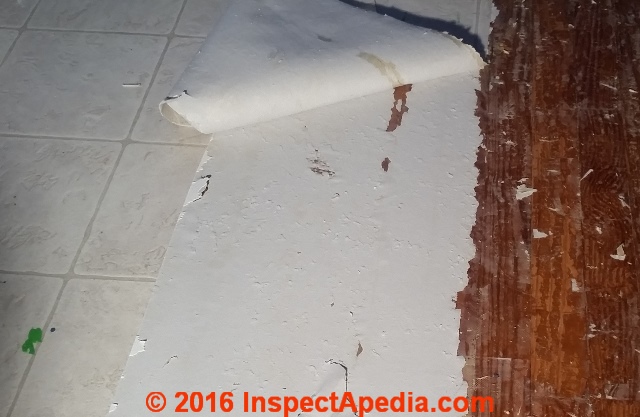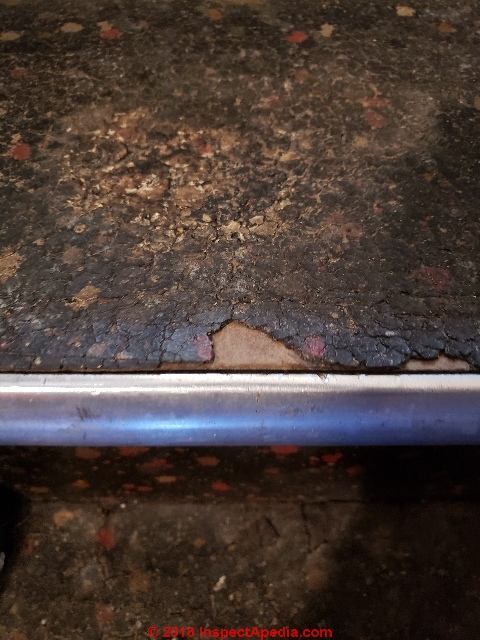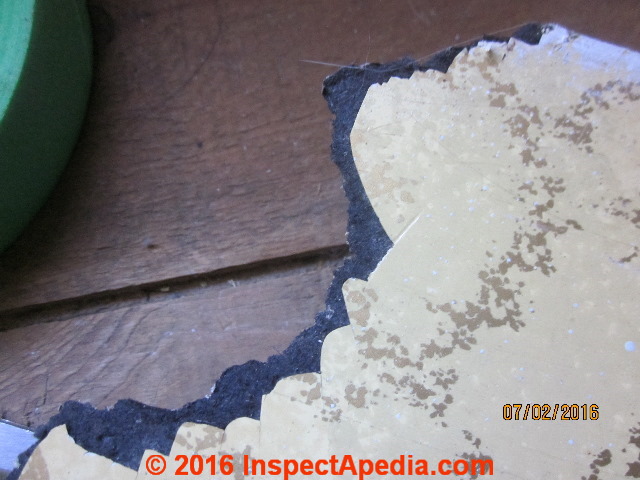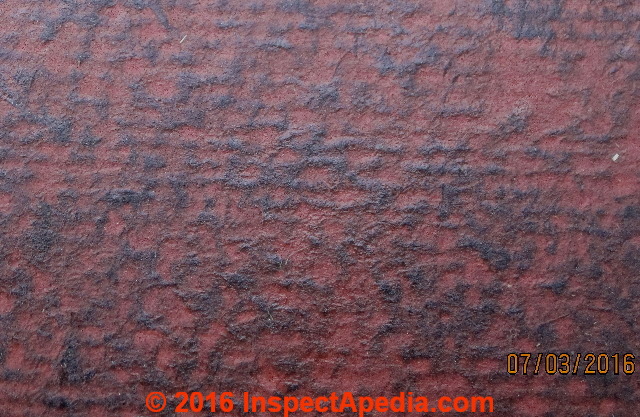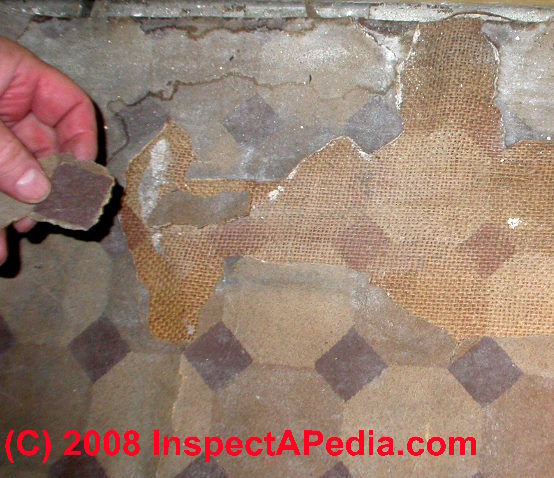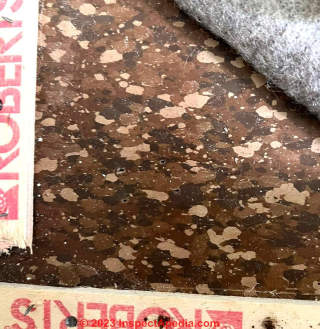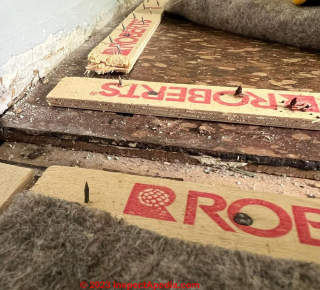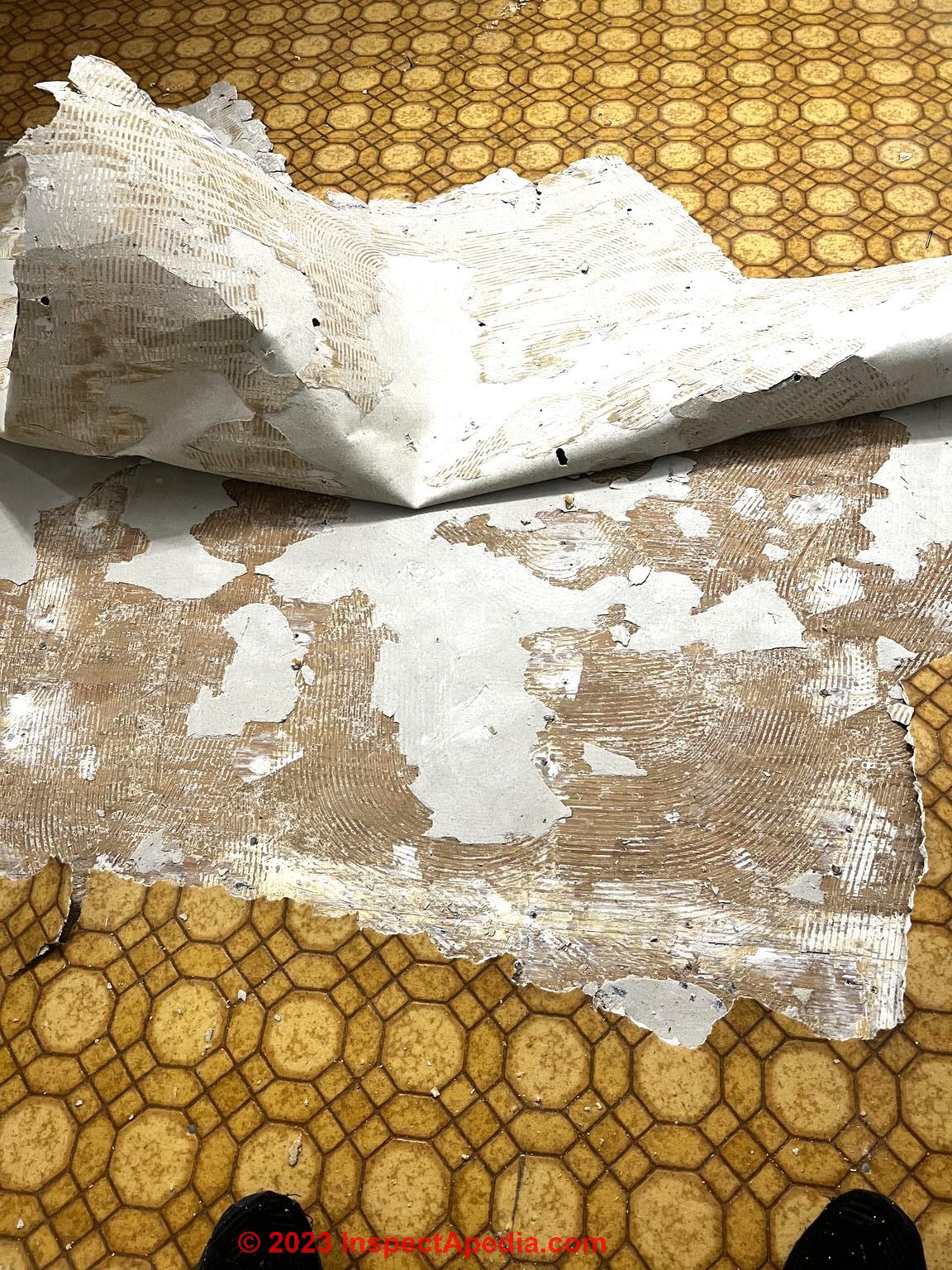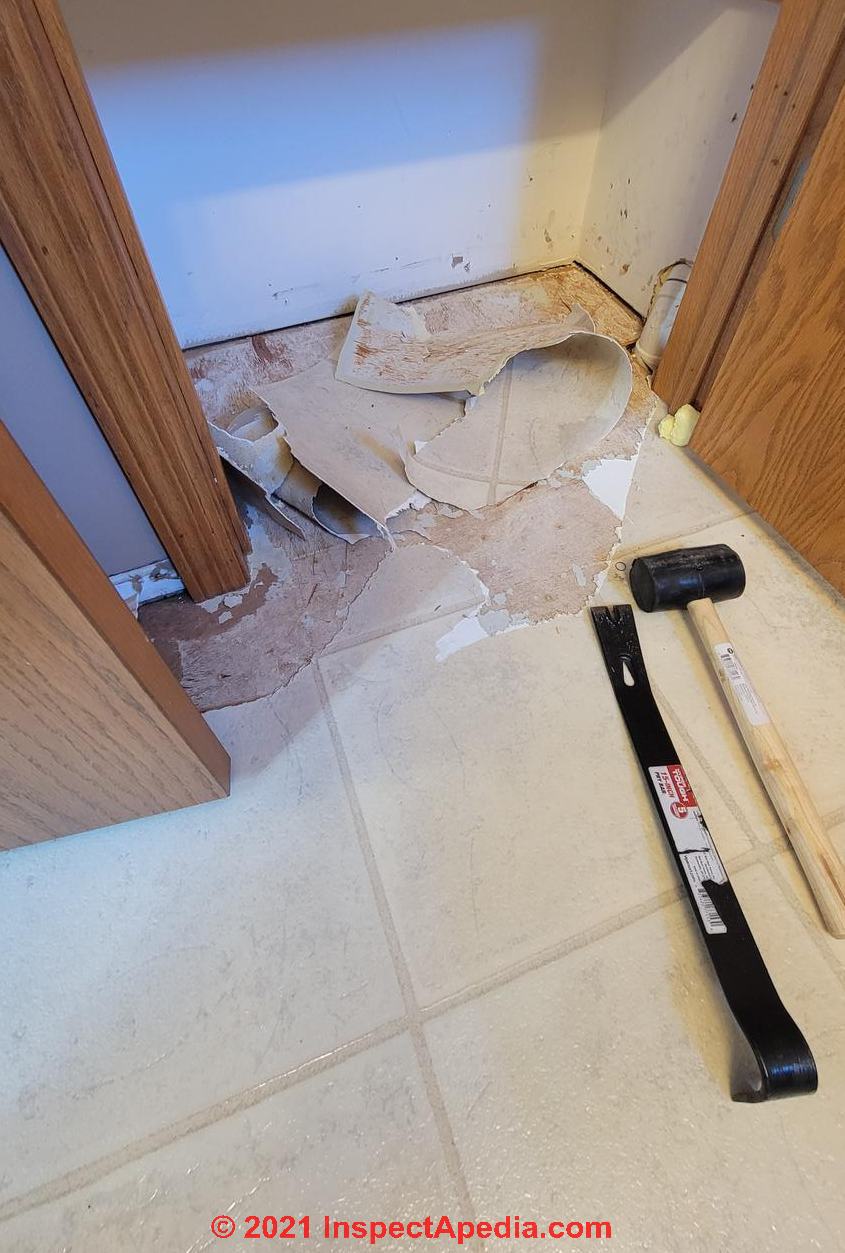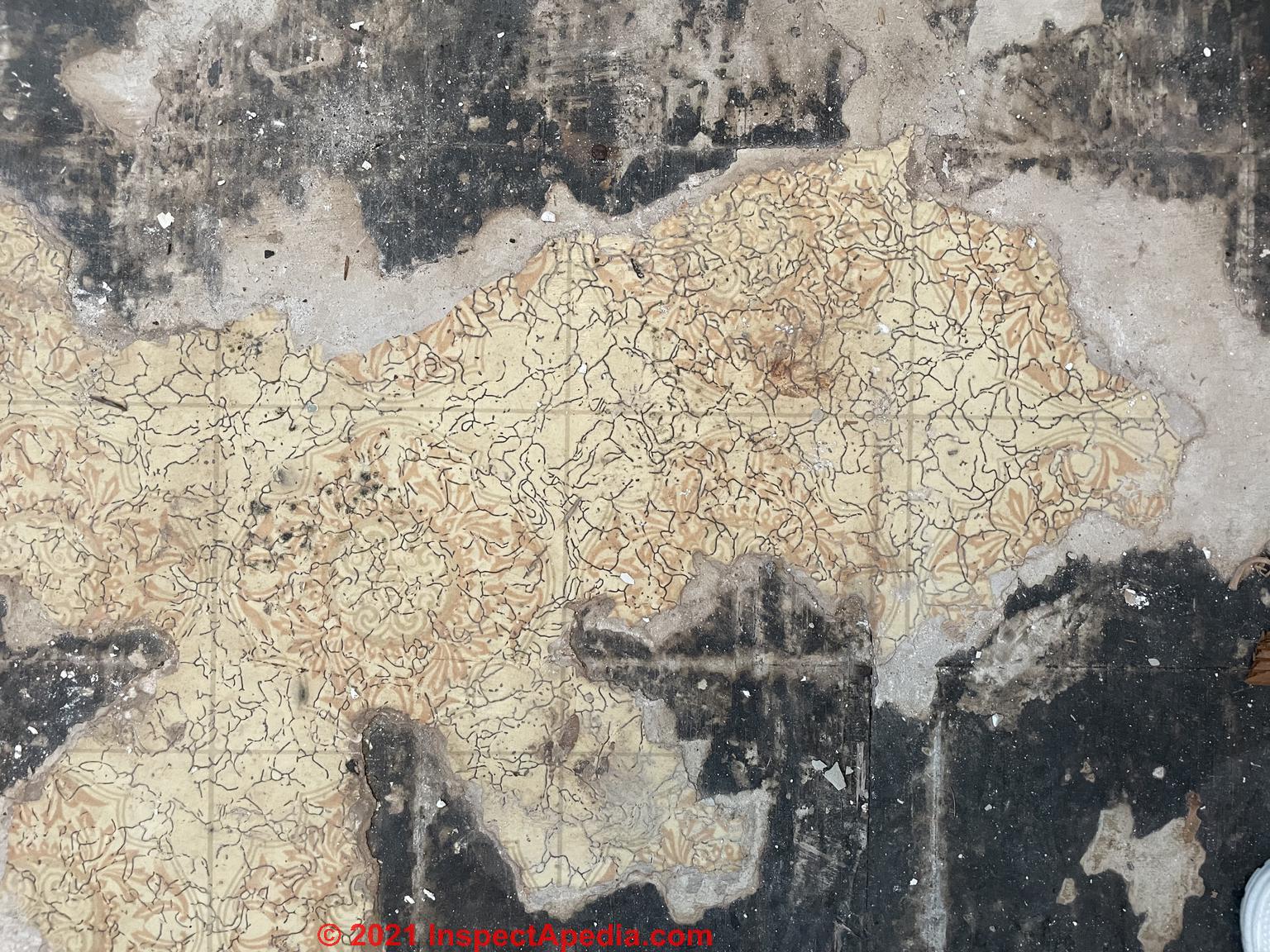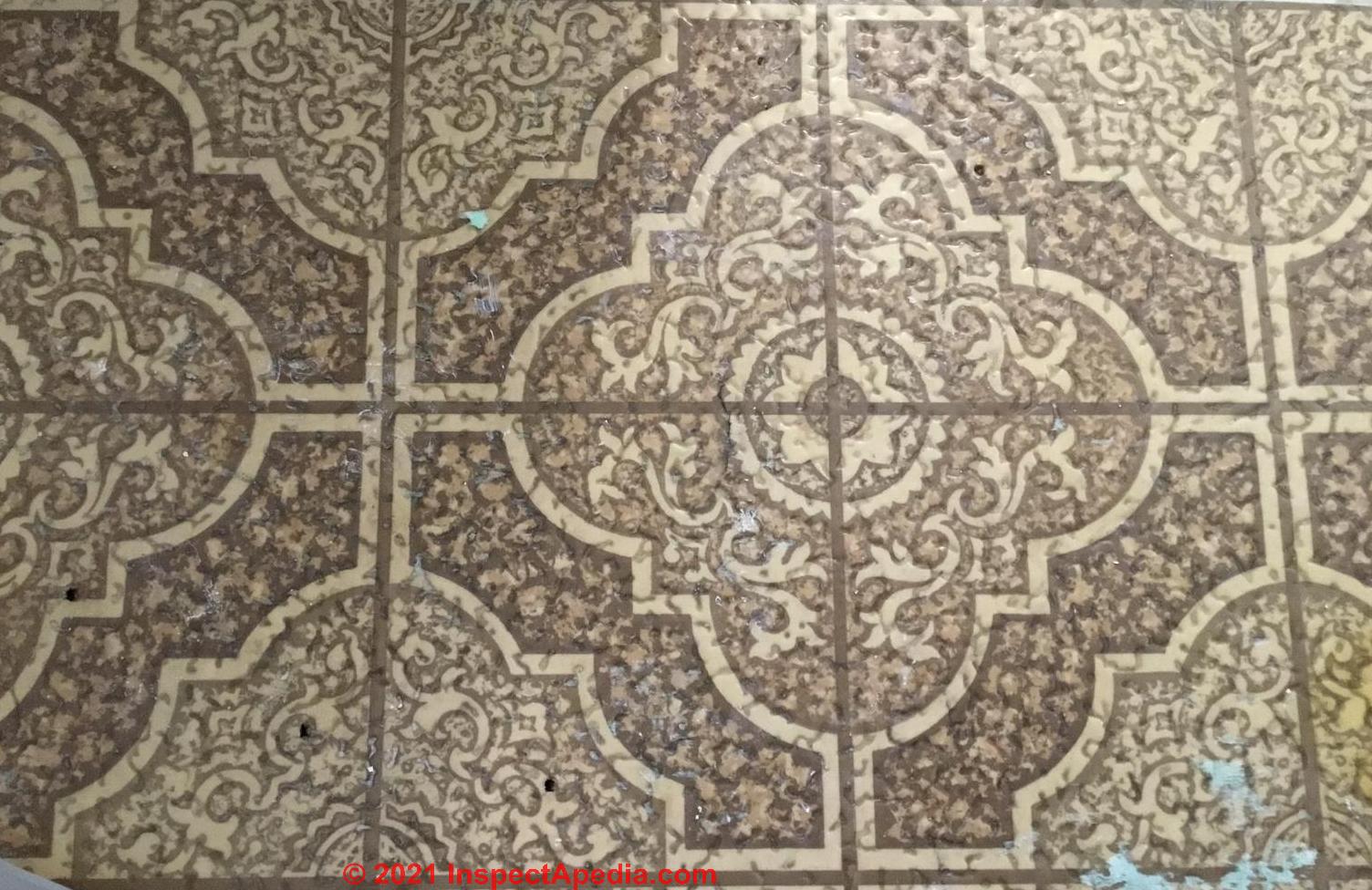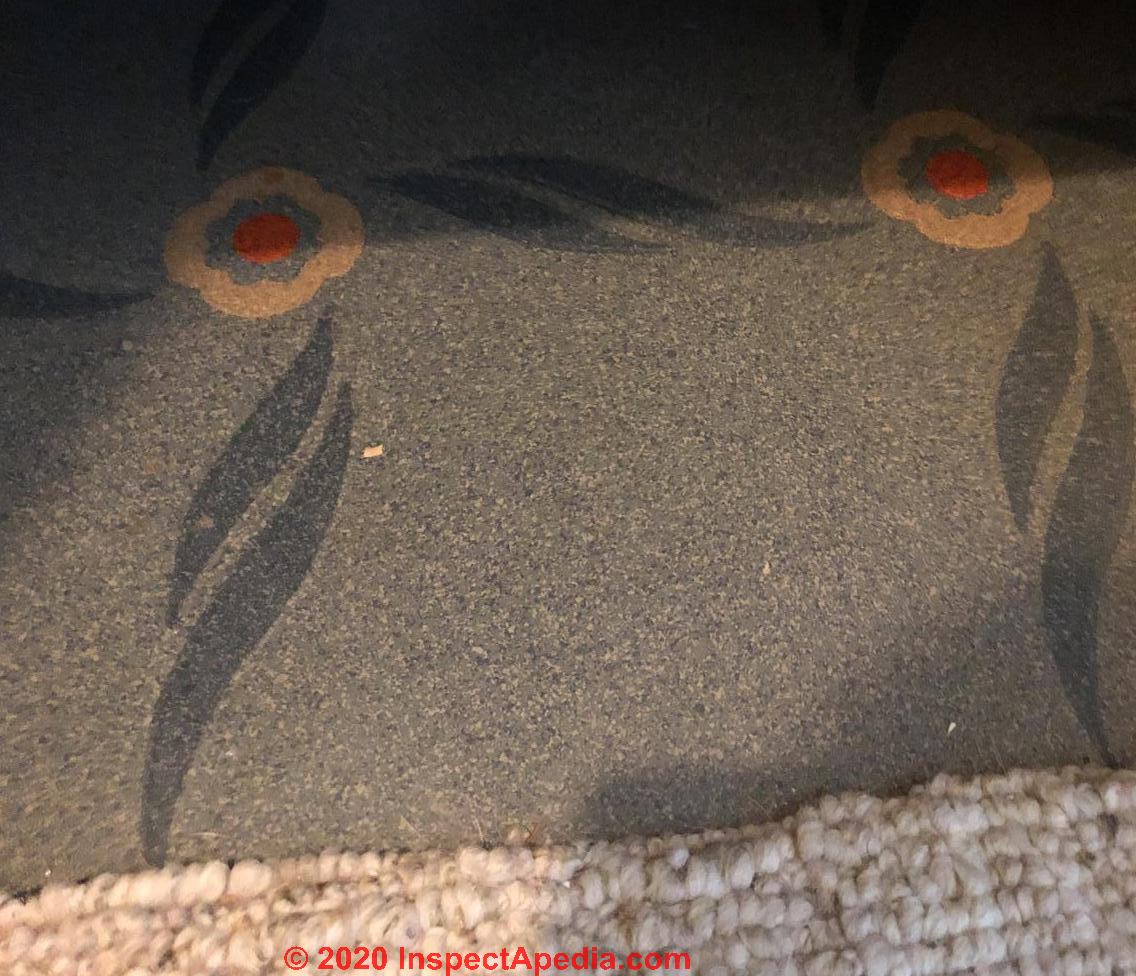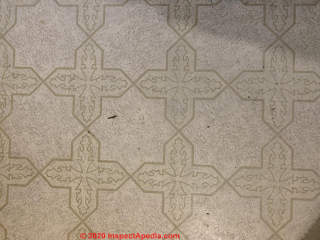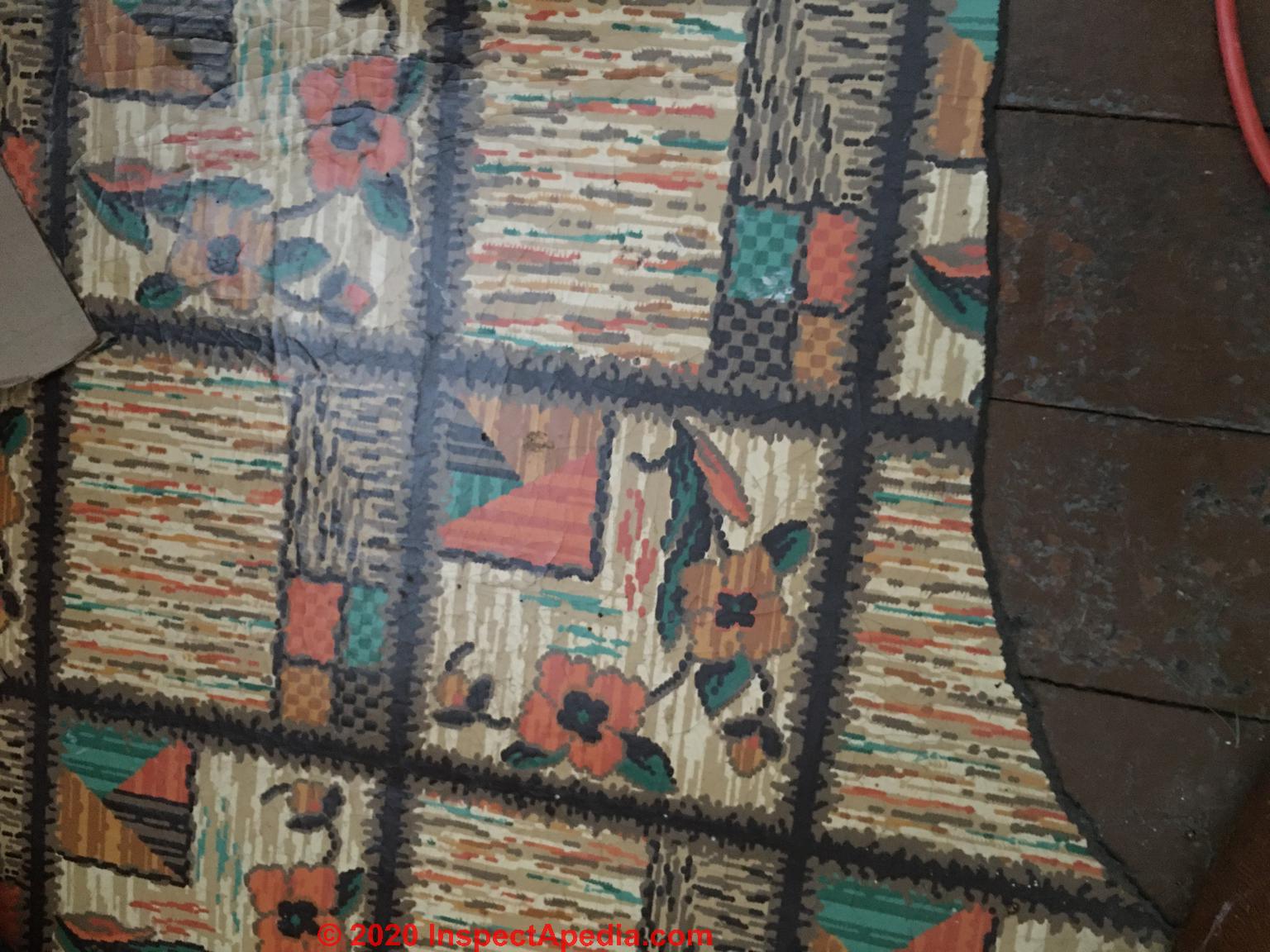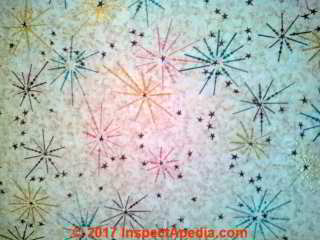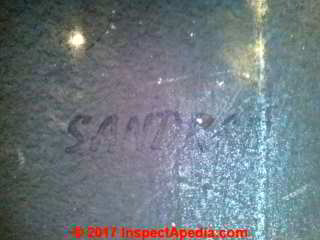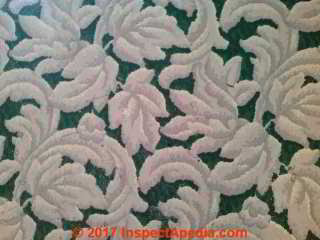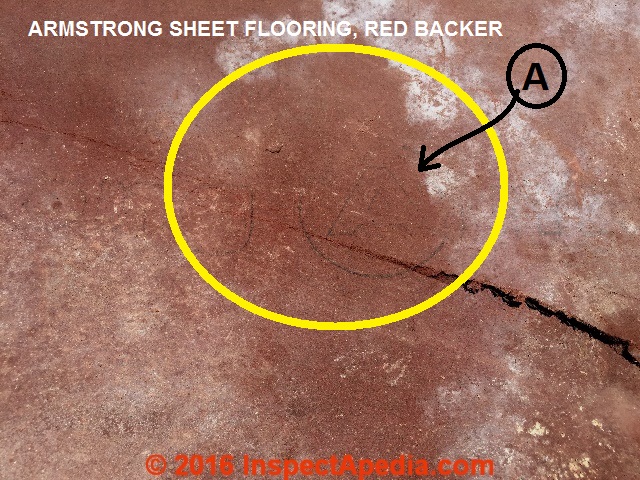 Identify Resilient / Sheet Flooring Types
Identify Resilient / Sheet Flooring Types
that May Contain Asbestos
- POST a QUESTION or COMMENT about types of sheet flooring products that might contain asbestos
How to recognize different types of sheet flooring or resilient flooring:
Black asphalt felt, white cushioned, and red-backed flooring materials can be confusing to identify. This article describes different types of sheet flooring or resilient flooring as an aid to determining whether or not a floor covering is likely to contain asbestos.
We describe the different types of backing used on the under-side of sheet flooring, resilient flooring, vinyl flooring, and rubber-backed flooring and we include links to material identifying older types of non-asbestos linoleum sheet flooring.
This article series describes sheet flooring products known to contain significant levels of asbestos. We describe sources of asbestos in older forms of sheet flooring including felt-backed flooring, rubber-backed flooring, and vinyl cushion-backed resilient flooring products. We include research citations on asbestos use in sheet flooring backer materials.
InspectAPedia tolerates no conflicts of interest. We have no relationship with advertisers, products, or services discussed at this website.
- Daniel Friedman, Publisher/Editor/Author - See WHO ARE WE?
How to Identify the Type of Sheet Flooring: Linoleum, Vinyl, Other
Three Flooring Backer Types Used with Vinyl Sheet-Flooring Products
Adding confusion to flooring terminology, sheet vinyl flooring referred to in some product literature and other materials as "vinyl flooring" or "sheet vinyl flooring" contained asbestos-containing backers that may have been solid vinyl (sometimes containing asbestos) that is typically white or cream colored, or asphalt-impregnated felt (sometimes containing asbestos) that is virtually always black in color but that may have been coated on its underside with red material, possibly rubber (sometimes containing asbestos).
Above and below, two white-backed sheet flooring products, from Armstrong and from White Shield backer.
Vinyl resin-based sheet flooring was produced with these different backing materials and properties:
Properties of Various Sheet Vinyl Flooring Types & Flooring Backer Materials |
||||
| Flooring Material | Flooring Properties | Recommended Use | Wear Layer Thickness (Inches) |
Installed Price per Sq.Ft. U.S.A. 1972 |
| Vinyl Resin Sheet Flooring Asbestos Backed, Medium or Heavy Gauge | Excellent quality. Long-wearing. Inlaid design. Highly resistant to grease and alkalies. Easy to keep clean. Resists scratches. Many colors and designs. The thicker the vinyl wear layer thickness the longer the material will be expected to wear. Little waxing needed. [Note: backer contains asbestos - Ed.] |
All grade levels 1 | 0.025 - 0.50 " | $0.55 - 1.40 |
| Vinyl Resin Sheet Flooring Asbestos Cushion Backed | Same quality vinyl resins as above, plus foam cushion for comfort. Easy to stand on, low noise level. [Note: backer contains asbestos - Ed.] |
All grade levels | 0.030 - 0.050" | $1.10 - 1.25 |
| Vinyl Resin Flooring Asphalt Felt Backed | Quality vinyl. Medium wear layer thickness. Will last many years with proper care. [Note: backer may contain asbestos - Ed.] |
Suspended 2 | 0.025" | $0.45 - 0.55 |
| Rotovinyl Sheet Flooring Asbestos Back-cushioned | Durable vinyl coating. Easy to clean. Resists grease and alkalies. Many colors and design, low cost. [Note: backer may contain asbestos - Ed.] |
All grade levels | Vinyl covering over printed design | $0.55 - 0.65 |
| Rotovinyl Sheet Flooring Asphalt Felt Paper-Backed | Durable vinyl coating. Easy to clean. Resists grease and alkalies. Many colors and design, low cost. [Note: backer may contain asbestos - Ed.] |
Suspended | $0.45 - 0.55 | |
Notes to the table above
1. Grade level was defined by Womble as the physical location of the floor in relationship to the ground under or around the building. The three grade levels in building construction are suspended (or "above grade"), on-grade, and below grade.
An on-grade level floor is at or very slightly above ground level with no ventilated air space below. A below-grade level subfloor is all or partly below ground level and is in direct contact with the ground or with a fill that is in direct contact with the ground. A concrete "slab on grade" is a grade-level subfloor or floor.
2. Suspended floor was defined by Womble as at least 18" above the level of surrounding soil. It may be over a basement or a well-ventilated space. Currently builders refer to this level as "above grade"
Source: excerpted from
- Womble, Charlotte, "EC72-2015 A Resilient Floor for Every Use, Taste, and Budget", [PDF] North Carolina Agricultural Extension Service, Raleigh NC USA, (May 1972), retrieved 2016/06/28 original source: http://digitalcommons.unl.edu/cgi/viewcontent.cgi?article=5436&context=extensionhist
This article also describes properties of asphalt tile, vinyl-asbestos tile, and linoleum or "battleship linoleum" (basically a heavy-grade or thicker linoleum product).
Details about this older non-asbestos floor covering material are
Examples of Vinyl Sheet Flooring Backer Types, Colors, Materials
Unless you have used a certified asbestos test lab to confirm that there is no asbestos in these materials, if your flooring dates before 1988, in most countries it would be prudent to treat the floor covering as PACM - Presumed Asbestos-Containing Material.
Some of these floor coverings can be simply lifted up, rolled-up, for disposal while others were adhered to the subfloor below.
- FELT-PAPER-BACKED FLOOR TILES
- SHEET FLOORING WHITE CORE WHITE BACKED
- SHEET FLOORING BLACK CORE WHITE BACKED
- SHEET FLOORING BLACK CORE RED BACKED
- SHEET FLOORING JUTE or BURLAP BACKED
- WHITE SHIELD® BACKING ASBESTOS in FLOORING
- also see ASBESTOS-CONTAINING ADHESIVES
Adhered floor coverings may present a greater risk of asbestos exposure depending on how and how easily they can be removed.
Watch out: some floor adhesive mastics also contained asbestos.
White Core, White Backed Vinyl Sheet Flooring
Below: white core and white-backed vinyl sheet flooring.
Also see WHITE SHIELD® BACKING ASBESTOS in FLOORING
Black Core, White Backed Sheet Flooring, cracked, worn
Above and below: spatter-pattern white-backed black or dark core sheet flooring from a 1954 home in Milwaukee, Wisconsin, thanks to an InspectApedia.com reader whose comments are below.
Reader question about this floor:
This sheet flooring has been exposed in my parents' house on the stairs leading to the basement. It has been there for my whole life (I'm 19), and only recently did I realize that it might contain asbestos.
I have attached 3 photos, one of the stairs in general, one of an exposed part of the backing, and one with a section of the flooring turned over.
I took off a piece of the paper-like backing and tried to burn it. It smokes and chars, but does not hold a flame. We are possibly going to get it tested soon, but I would still like a professional opinion.
Not only am I concerned about that area, but I discovered the same flooring in the hallway on the main floor. We had new carpet installed today, but we decided to do the removal ourselves, which involved scraping old carpet padding off of these floors.
There are a few spots where the black upper part is gone leaving the backing exposed. I can't get pictures of this as the new carpet is already installed over it.
The house was built in either 1952 or 1954, we are unsure of the exact year, and the flooring is original.
I'm very worried as the basement stairway is a well-traveled area and we are walking over this stuff daily. - Anonymous by private email.
Reply:
OPINION: This floor was in very worn condition, cracking, but mostly staying in place. Our advice is to leave the floor alone, covering-it over with new sheet flooring or with carpeting.
Until you have the test results from an asbestos test lab, if you avoid creating a dusty mess (grinding, chopping, sawing, sanding) the floor, you will minimize the risk of sending potentially harmful dust about your home.
If demolition was required, because some white-backed sheet flooring contains asbestos, we recommended that the owner have a sample tested by a certified asbestos test lab - references are
This flooring was identified by the reader as most-likely Armstrong Linoleum Spatter Pattern No. 5001 Mantilla Black and is discussed further
at SHEET FLOORING NON-ASBESTOS EXAMPLES
Black Core Red Backed Sheet Flooring
Below, red backed asphalt core vinyl sheet flooring.
Below: asphalt core vinyl sheet flooring with a red coating on the floor underside, provided by reader W.T.
At ASPHALT BASED SHEET FLOORING we report that some tests of red-backed asphalt core vinyl sheet flooring found that the floor did not contain asbestos.
But other asphalt-impregnated felt products and floor backers did contain asbestos, so unless you have had a lab test performed it would be prudent to assume that the material contains asbestos.
See ASBESTOS TESTING LAB LIST if you need asbestos testing services and be sure to only use an asbestos-test-certified testing laboratory.
See RED-UNDSIDED FLOORING PRODUCTS.
Below: Red-backed Congoleum flooring (CONGOLEUM NAIRN SHEET FLOORING 1960 - 1980)
and below, white-backed and stamped Armstrong flooring
ARMSTRONG SHEET FLOORING 1940 - 1980
Jute or Burlap Fabric Backed Flooring
Burlap-backed older sheet flooring (below) would not be expected to contain asbestos.
See BURLAP / JUTE - BACKED SHEET FLOORING
(Additional vinyl asbestos, linoleum, & other sheet flooring & flooring backing photos & asbestos lab test results wanted - CONTACT US)
Check the Sheet Flooring Material to Identify Linoleum or to Check for Sheet Flooring Likely to Contain Asbestos
This topic has been moved to SHEET FLOORING INSPECT / TEST.
There we explain that simple visual inspection can often distinguish among linoleum (jute or burlap backed), asphalt saturated felt-backed flooring, vinyl sheet flooring (white or light colored backing), and cork (simple visual appearance).
We also describe using odorless paint thinner to detect asphalt-based floor types - an important consideration as some saturated felt flooring backers contained asbestos.
The resilient sheet flooring shown above is a modern product and does not contain asbestos.
But before about 1978, in products that looked like this same material, asbestos fibers were used as a strengthen material on vinyl sheet flooring backing.
How to Identify Sheet Flooring Known to Not Contain Asbestos
See LINOLEUM & SHEET FLOORING for a description of linoleum products that do not contain asbestos.
See SHEET FLOORING NON-ASBESTOS EXAMPLES - separate article
Older sheet flooring that Does Not or is Unlikely to Contain Asbestos
This discussion has moved
to SHEET FLOORING NON-ASBESTOS EXAMPLES
Shown above: traditional linoleum flooring.
...
Reader Comments, Questions & Answers About The Article Above
Below you will find questions and answers previously posted on this page at its page bottom reader comment box.
Reader Q&A - also see RECOMMENDED ARTICLES & FAQs
Can I put nailed-in hardwood flooring over my 1950s 9x9 tiles?
I found these 9x9 1950s tiles under my carpet. Does anyone positively recognize them as containing asbestos?
I am considering replacing the carpet with nailed-in hardwood flooring. The nails would need to go through the tiles.
Is this a bad idea? Is it recommended to opt for a "floating" install instead? Regardless of nailed vs floating install would a vapor barrier be recommended?
Thanks! - On 2023-06-05 by John
InspectApedia DF (mod) -
@John,
I would treat those tiles as presumed to be asbestos containing material. Compare your pattern to Armstrong's dark or medium Corkstyle asphalt asbestos tiles from 1955 (image shown here):
BEIGE, BROWN, TAN OR WOOD-TONE ASPHALT ASBESTOS & VINYL ASBESTOS FLOOR TILES
https://inspectapedia.com/hazmat/Armstrong-Corkstyle-Colors-1955.jpg
The simplest and safest recommendation is to leave the flooring in place and cover with the new flooring you'd like to put down. You would not need a vapor barrier.
Read more in this article (live link found in the Recommended Articles just above on this page)
ASBESTOS FLOORING HAZARD REDUCTIONBasically, you can and will want to remove the tack strips, working carefully to minimize damage to those old floor tiles. For example, use a bit of thin plywood between the underside of your flat bar or pry bar and the floor when removing the tack strips.
Then damp wipe/HEPA vac up the little bit of dust and debris that will come up where the tack strip nails penetrated the floor.
If those tiles are glued to a concrete slab, nailing down hardwood isn't in my opinion practical. So what kind of subfloor do we have?
Even if your existing tiles are on a wood subfloor over joists, nailing through those tiles is probably a bad idea: they are old and brittle and tend to break when nailed. The result can be bits of displaced flooring that make your new boards refuse to sit flat and evenly on the tiles.
So you could try it but I'd be inclined to add a layer of subfloor plywood or OSB first. Locate and mark the joist locations with ticks along the walls, then you can shoot screws right through the new subfloor into the joists.
What do you think.
What kind of red sheet flooring is this with felt like backer?
Hello , pulled up old pergo and on top of original wood is red sheeting with a felt like back. Would you be able to identify? I have called an inspector to test - On 2023-04-18 by Melanie
Reply by InspectApedia Editor - Congoleum sheet flooring? Not asbestos
@Melanie,
Take a look at the red-backed Congoleum sheet flooring described at
https://inspectapedia.com/interiors/Linoleum_Flooring.php LINOLEUM & SHEET FLOORING
and then also see the sheet flooring examples at
https://inspectapedia.com/hazmat/Sheet_Flooring_Identification.php RESILIENT SHEET FLOORING ID GUIDE for some newer products.
Asbestos test results from Melanie - no asbestos found in this old sheet flooring
@InspectApedia Editor , thank you! I got results back today and showing no asbestos. Sharing report if you would like to share on page. Such a helpful site! I also had old brick mortar and brick veneers tested , also negative.
Reply by InspectApedia Publisher - red flooring asbestos test results for one type
@Melanie,
Thank you, this will also help other readers.
What kind of floor covering is this in my house built in 1900?
Hello. I pulled up a wooden overlayment on my steps which was adhered with a black adhesive. I scraped some off unknowingly and have had it like this for 2 years.
I just now became aware of the possibility of it containing asbestos. My house was built in 1900- I only purchased 4 years ago, so I do not know the history.
Can you tell me if this is likely asbestos containing adhesive? There is lead paint underneath covered with non lead paint. - On 2022-11-12 by Hayley
Reply by InspectApedia (Editor) - mid 1980s black mastic adhesive may contain asbestos
@Hayley,
If you're building is located in North America and that mastic adhesive was placed there before the mid 1980s then it's quite possible that it contains asbestos. Fortunately it's not a highly friable material.
The best course of action will be to paint over it with a sealant paint intended for that purpose.
We describe those products here at inspectApedia.com
at
https://inspectapedia.com/hazmat/Asbestos-Sealers-Encapsulants.php
ASBESTOS SEALANTS & ENCAPSULANTS
Do you agree that this is an Armstrong floor? House is from 1984
I’m guessing this is bad. Armstrong flooring. House built in 1984. - On 2022-10-14 by Max
Reply by InspectApedia-911 (mod) - damaged flooring requires further attention
@Max,
I agree that that flooring is in bad shape;
If it was made in the U.S. before the mid 1980's it'd be prudent to treat it as presumed to contain asbestos; details on wetting, removing, cleaning-up are given in links on this page under these titles
ASBESTOS FLOORING HAZARD REDUCTION
ASBESTOS FLOORING IDENTIFICATION
ASBESTOS FLOORING REMOVAL GUIDE
ASBESTOS REMOVAL, WETTING GUIDELINESFollowup by Max
@InspectApedia-911, I sealed it up with primer and levelling concrete where I removed it and am currently installing the new flooring over it.
I didn’t want to take the chance. I’ve been running Hepa air purifiers ever chance with air quality sensors.
Reply by InspectApedia-911
@Max,
Good moves.
Is this 1999 sheet flooring likely to contain asbestos?
I started pulling up sheet flooring in my bathroom and then I realized it might have asbestos. The house was built in 1999 and the flooring is original. Looks like white core sheet vinyl. Could this contain asbestos? - On 2021-12-21 by Jonny
Reply by Inspectapedia Com Moderator - No
@Jonny,
If your home is in North America, no. Asbestos use in flooring in North America was discontinued in 1987.More by Jonny - what about asbestos in the 1999 flooring adhesive?
@Inspectapedia Com Moderator, thanks for the quick reply, does that apply to the adhesive as well?
Reply by Inspectapedia Com Moderator - no asbestos
@Jonny,
Yes. the same conclusion applies
Weird sticky subfloor over even older stuff in a 1954 house: what kind of floor is this
Pulled up several layer of ceramic, vinyl and a weirdly sticky subfloor to reveal another subfloor with some residual flooring . I want to pull up this subfloor and replace , but is this remaining flooring asbestos? House is from 1954 - On 2021-09-17 by Is this sheet flooring asbestos type?
Reply by Inspectapedia Com Moderator
@Is this sheet flooring an asbestos type?,
Quite likely, yes, at least in the backer and possibly in the mastic adhesive.
Who made this 1982 sheet flooring?
Would anyone know who made this sheet flooring? Likely contain asbestos? House built 1982-83. - On 2021-04-10 by C
Reply by danjoefriedman (mod) - looks like an Armstrong floor pattern
@C, Armstrong is a plausible guess
Followup by C
@danjoefriedman, the backing is seen on top of photo. Do you think it contains asbestos? Had to remove it because of water damage to sub floor. Contractor firmly believes because of the age of the house it is asbestos free 1982-83.
Reply by danjoefriedman (mod)
@Anonymous,
White or gray backing on vinyl sheet flooring made before 1986 could well contain asbestos.
Happily if it's not damaged it's not friable so not hazardous if left alone.
What type is this old sheet flooring in a 1947 Minnesota Home?
Found this underneath dining room carpet. Extremely thin sheets (~1mm?) with embossed design.
House was built in 1947 in MN so I would think it is a Congoleum, Armstrong Lino Floor, or Dominion Oilcloth product. Anybody have any ideas? I was thinking of heating up a bit and peel it in the closet to get it tested. - On 2020-12-06
by Paul
Reply by (mod) - linoleum rug type floor covering asbestos?
Your flooring does look like an antique linoleum or similar sheet flooring product;
Watch out: sometimes the asphalt-paper backer of linoleum flooring contains asbestos.
Safest is to leave it alone, in place, covered over.Followup by Paul
One more thing. If I do put LVP down would you float it or glue it down. I would guess floating it to prevent it tearing up if the floor is updated down the road.
Thanks Dan. Will let you know if I get it tested. Might just put LVP over it and call it a day. Should I try to encapsulate it or is the main concern the backing?
Reply by (mod) -
I agree on floating the covering floor layer as the safest approach.
Does this light colored sheet flooring contain asbestos? No markings on its back.
Does this sheet flooring contain asbestos?
I can't find an example on the site with this image, also can't find anything on the back of the flooring to ID. Thank you! - On 2020-11-15 by Ian
Reply by (mod) -
Ian, I don't know that exact flooring pattern either. But finding an exact match isn't a definitive answer anyway because some popular patterns of flooring that contained asbestos continued in production later after asbestos was no longer used.
But you can see https://inspectapedia.com/hazmat/DIY-Asbestos-Floor-Test.php for help in making a reasonable guessFollowup by Ian
Thank you for your reply. I think 'm going to be cautious and treat it as asbestos.
The house was built in 1974 so it seems very possible and why not be safe. It also tears very easily and the backing is a white paper like material. Don't know if that helps identify it more?
Reply by (mod) -
No, that doesn't
What is this old style sheet flooring with grey paper-like backing
Hi. I am tearing out the kitchen floor and the last floor covering above the concrete slab is sheet vinyl with a grey paper like backing.
The sheet has a wood pattern, hard wood flooring type of image on it and I was wondering when these styles of patterns came about.
Most of the sheet flooring that I have seen on this website and thought to contain asbestos, are not in these faux wood floor patterns.
This is a very old house, age of material is unknown.Sheet is black paper material and does not appear to be glued down. Does this contain asbestos?
Do I need to be concerned, or are wood patterned sheets a newer, non toxic flooring? - On 2020-01-22 by Karen
Reply by (mod) -
Nice photo of an antique linoleum "rug", Karen.
That looks like sheet flooring linoleum with an asphalt-felt paper backer.
What are the country, city, and age of the home where this floor is installed?
In the ARTICLE INDEX you'll find links to information about that product and to possible asbestos content in asphalt-paper backers.I can't guess about asbestos risks or content from the information from general questions: that is, if we know the country, city, age of home and age of material then we can can lead to a reasonable guess about asbestos - else if you have to demolish the floor making a dusty mess then consider taking a test sample to an asbestos test lab.
See DOES THIS FLOORING CONTAIN ASBESTOS?
Question: can you identify this sheet flooring marked Best Sandran Quality
I removed today from a bedroom in my home in Canada. ... I enclosed a couple of pics ot the flooring I removed.
The starburst design had a black papery backing and the name Best Sandran QualityOn the back.
I attached a pic of the design and also of the name on the back which was hard to read. I think it might be related to the Tarkett Sandran company but not sure.
I couldn't find any starburst designs on your site - I spent a few hours researching the flooring I removed. When I tried to roll it up it snapped loudly. I finally snapped it into a bundle - tied it up and took it outside.
The older piece I think was installed in 1949 as I found a piece of newspaper with that year on it in a floor board.It had a red backing with a black inner core.
It was lightweight. I wanted to take it out in one piece but it kept breaking easily so bagged it up.
I really hope these don't contain asbestos as I removed them both myself.
They were under a dirty carpet which caused alot of dust but I am pretty sure it was the dirt from the carpet not dust from the flooring.
I washed the floor after really well and am going to prime and paint it like I did the other room as it has wide boards painted a hideous green likely containing lead paint.
Reply:
Above: the back imprint on the starburst resilient sheet flooring pattern shown above, reading Best Sandran Quality.
The term "Sandran flooring" is still in popular use but I've not found its history and I'm still researching it. I'll post further details here.
OPINION: If you managed to avoid creating a dusty mess, the possible asbestos or other fiber hazards from simply rolling up an old floor that breaks at folds is probably beneath detection.
Below: provided by the same reader, this flooring, found below the Sandran floor shown above, was a 1940's Congoleum asphalt-saturated felt backed sheet flooring that was a less-costly linoleum-like product.
The floor shown above is a floral pattern linoleum skin imprint affixed to an asphalt saturated felt backer. It is discussed in detail
Thank you to our readers for their generous comments
On 2019-12-26 by James Matthews
Thanks so much for your thoughtful, detailed response. I greatly appreciate it. It was like a Christmas gift, and I thank you.
...
Continue reading at SHEET FLOORING INSPECT / TEST or select a topic from the closely-related articles below, or see the complete ARTICLE INDEX.
Or see ASBESTOS SHEET FLOORING ID FAQs - questions & answers posted originally at this page
Or see these
Recommended Articles
- ASBESTOS FLOORING HAZARD REDUCTION
- ASBESTOS FLOOR IDENTIFICATION - home - tiles & other products
- DOES THIS FLOOR CONTAIN ASBESTOS? - 5 easy questions to tell if your FLOOR probably contains asbestos -
- DOES THIS MATERIAL CONTAIN ASBESTOS? - 5 easy questions to tell if a BUILDING MATERIAL probably contains asbestos -
- ASBESTOS FLOORING HAZARD REDUCTION
- ASBESTOS FLOORING IDENTIFICATION
- ASBESTOS FLOORING REMOVAL GUIDE
- ASBESTOS REMOVAL, WETTING GUIDELINES
- ASBESTOS TESTING LAB LIST
- IDENTIFY SHEET FLOORING TYPE
- POURED-IN-PLACE FLOORING, RESILIENT
- RESILIENT SHEET FLOORING ID GUIDE - home
- SHEET FLOORING INSPECT / TEST
- SHEET FLOORING NON-ASBESTOS EXAMPLES
- SHEET FLOORING POSSIBLE ASBESTOS - 1960-1987
- SHEET FLOORING INSPECT / TEST
- SHEET FLOORING TYPE IDENTIFICATION
Suggested citation for this web page
IDENTIFY SHEET FLOORING TYPE, HOW TO at InspectApedia.com - online encyclopedia of building & environmental inspection, testing, diagnosis, repair, & problem prevention advice.
Or see this
INDEX to RELATED ARTICLES: ARTICLE INDEX to ASBESTOS HAZARDS
Or use the SEARCH BOX found below to Ask a Question or Search InspectApedia
Ask a Question or Search InspectApedia
Try the search box just below, or if you prefer, post a question or comment in the Comments box below and we will respond promptly.
Search the InspectApedia website
Note: appearance of your Comment below may be delayed: if your comment contains an image, photograph, web link, or text that looks to the software as if it might be a web link, your posting will appear after it has been approved by a moderator. Apologies for the delay.
Only one image can be added per comment but you can post as many comments, and therefore images, as you like.
You will not receive a notification when a response to your question has been posted.
Please bookmark this page to make it easy for you to check back for our response.
IF above you see "Comment Form is loading comments..." then COMMENT BOX - countable.ca / bawkbox.com IS NOT WORKING.
In any case you are welcome to send an email directly to us at InspectApedia.com at editor@inspectApedia.com
We'll reply to you directly. Please help us help you by noting, in your email, the URL of the InspectApedia page where you wanted to comment.
Citations & References
In addition to any citations in the article above, a full list is available on request.
- Womble, Charlotte, "EC72-2015 A Resilieint Floor for Every Use, Taste, and Budget", [PDF] North Carolina Agricultural Extension Service, Raleigh NC USA, (May 1972), retrieved 2016/06/28 original source: http://digitalcommons.unl.edu/cgi/viewcontent.cgi?article=5436&context=extensionhist
- Richa Wilson, Kathleen Snodgrass, " EARLY 20TH-CENTURY BUILDING MATERIALS: RESILIENT FLOORING " [Very large PDF], Richa Wilson, Intermountain Regional Architectural Historian Kathleen Snodgrass, Project Leader, United States Department of Agriculture Forest Service, Technology & Development Program, August 2007, 7300-0773-2322-MTDC. Contact Kathie Snodgrass at MTDC: Tel: 406–329–3922, Email: ksnodgrass@fs.fed.us or Richa Wilson, author; USDA Forest Service, Intermountain Region, 324 25th Street, Ogden, UT 84401. Phone: 801–625–5704; fax: 801–625–5229: e-mail: rwilson@fs.fed.us
- Resilient Floor Covering Institute, 401 East Jefferson Street, Suite 102, Rockville, MD 20850, Tel: 301–340–8580, Website: http://www.rfci.com
- In addition to citations & references found in this article, see the research citations given at the end of the related articles found at our suggested
CONTINUE READING or RECOMMENDED ARTICLES.
- Carson, Dunlop & Associates Ltd., 120 Carlton Street Suite 407, Toronto ON M5A 4K2. Tel: (416) 964-9415 1-800-268-7070 Email: info@carsondunlop.com. Alan Carson is a past president of ASHI, the American Society of Home Inspectors.
Thanks to Alan Carson and Bob Dunlop, for permission for InspectAPedia to use text excerpts from The HOME REFERENCE BOOK - the Encyclopedia of Homes and to use illustrations from The ILLUSTRATED HOME .
Carson Dunlop Associates provides extensive home inspection education and report writing material. In gratitude we provide links to tsome Carson Dunlop Associates products and services.




